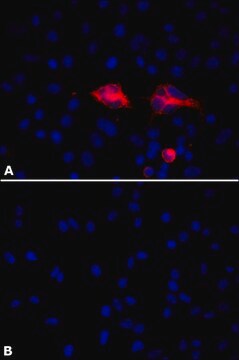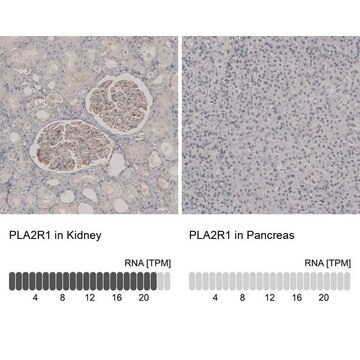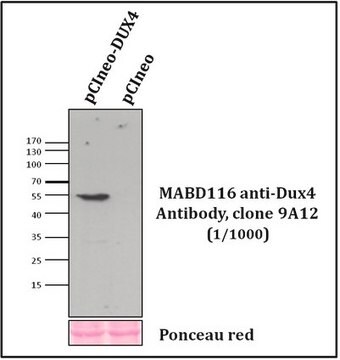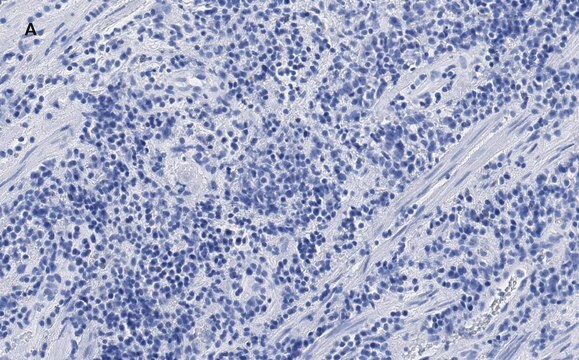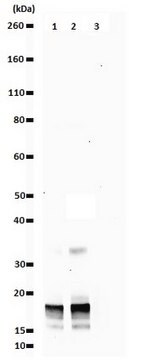推荐产品
生物源
rabbit
抗體表格
purified immunoglobulin
抗體產品種類
primary antibodies
無性繁殖
3C6, monoclonal
物種活性
human
技術
flow cytometry: suitable
western blot: suitable
同型
IgG1λ
NCBI登錄號
UniProt登錄號
運輸包裝
wet ice
目標翻譯後修改
unmodified
基因資訊
human ... PLAUR(5329)
一般說明
UPAR protein or CD87 acts as the receptor for urokinase plasminogen activator (uPA), or urokinase, an important enzyme commonly found in the blood and extracellular matrix fluids. UPA is the enzyme that is responsible for the activation of plasmin, a powerful serine proteinase necessary for clotting, wound healing, and extracellular matrix degradation and remodeling. Urokinase also has major roles in vascular disease and cancer growth and spreading. UPAR, the receptor, is also important in cancer biology as it is through this receptor that the uPA effects are mediated, and these effects play a role in cell adhesion, migration and cell proliferation of cancers. UPAR also binds vitronectin and uPAR associated proteins (uPARAP) as well as several members of the integrin family of proteins. UPAR’s primary physiological role is as part of the uPA activation system which is involved in tissue reorganization and wound healing. By binding urokinase it restricts the activation of plasminogen to plasmin to the immediate vicinity of the cell membrane and thus helps to regulate and limit the strength and duration of the remodeling process.
特異性
This antibody competes with beta 1 integrins for uPAR binding and inhibits uPAR-mediated cell invasion. Inhibition of uPAR is maximized with the combination of Anti-uPAR, clone 3C6 (Cat. # MABC89) and Anti-uPAR, clone 2G10 (Cat. # MABC88).
免疫原
Linear peptide corresponding to Human uPAR.
應用
Research Category
Apoptosis & Cancer
Apoptosis & Cancer
Research Sub Category
Apoptosis - Additional
Apoptosis - Additional
This Anti-uPAR Antibody, clone 3C6 (Azide Free) is validated for use in Western Blotting and Flow Cytometry and Inhibits Activity/Function for the detection of uPAR.
Western Blot Analysis: A representative lot of this antibody detected non-reduced uPAR recombinant protein (see Harel, E., et al., 2014 UCSF Scientific Poster).
Flow Cytometry Analysis: A representative lot of this antibody detected uPAR in MDA-MB-231, H1299 and PC3 cells (see Harel, E., et al., 2014 UCSF Scientific Poster).
Flow Cytometry Analysis: A representative lot of this antibody detected uPAR in HEK293 cells stably expressing uPAR (Dureseti et al., (2010) JBC. 285(35):26878–26888).
Inhibition Assay: A representative lot of this antibody inhibted the invasion of MDA-MB-231 cells (see Harel, E., et al., 2014 UCSF Scientific Poster). Inhibition of uPAR is maximized with the combination of Anti-uPAR, clone 3C6 (Cat. # MABC89) and Anti-uPAR, clone 2G10 (Cat. # MABC88).
Inhibition Assay: A representative lot of this antibody blocked uPAR-mediated invasion and signaling in H1299 cells (Dureseti et al., (2010) JBC. 285(35):26878–26888). Inhibition of uPAR is maximized with the combination of Anti-uPAR, clone 3C6 (Cat. # MABC89) and Anti-uPAR, clone 2G10 (Cat. # MABC88).
Flow Cytometry Analysis: A representative lot of this antibody detected uPAR in MDA-MB-231, H1299 and PC3 cells (see Harel, E., et al., 2014 UCSF Scientific Poster).
Flow Cytometry Analysis: A representative lot of this antibody detected uPAR in HEK293 cells stably expressing uPAR (Dureseti et al., (2010) JBC. 285(35):26878–26888).
Inhibition Assay: A representative lot of this antibody inhibted the invasion of MDA-MB-231 cells (see Harel, E., et al., 2014 UCSF Scientific Poster). Inhibition of uPAR is maximized with the combination of Anti-uPAR, clone 3C6 (Cat. # MABC89) and Anti-uPAR, clone 2G10 (Cat. # MABC88).
Inhibition Assay: A representative lot of this antibody blocked uPAR-mediated invasion and signaling in H1299 cells (Dureseti et al., (2010) JBC. 285(35):26878–26888). Inhibition of uPAR is maximized with the combination of Anti-uPAR, clone 3C6 (Cat. # MABC89) and Anti-uPAR, clone 2G10 (Cat. # MABC88).
品質
Evaluated by Western Blotting in reduced and non-reduced human uPAR recombinant protein.
Western Blotting Analysis: A 1:2500 dilution of this antibody detected uPAR in 1 µg of non-reduced human uPAR recombinant protein, but not in 1 µg of reduced human uPAR recombinant protein.
Western Blotting Analysis: A 1:2500 dilution of this antibody detected uPAR in 1 µg of non-reduced human uPAR recombinant protein, but not in 1 µg of reduced human uPAR recombinant protein.
標靶描述
~45 kDa observed.
Recombinant human uPAR (Leu23-Arg303) has a predicted molecular weight of ~31 kDa, but runs around ~45 kDa under non-reduced conditions.
Recombinant human uPAR (Leu23-Arg303) has a predicted molecular weight of ~31 kDa, but runs around ~45 kDa under non-reduced conditions.
外觀
Protein A purified
Format: Purified
Purified rabbit monoclonal IgGλ in buffer containing PBS without preservatives.
儲存和穩定性
Stable for 1 year at -20°C from date of receipt.
Handling Recommendations: Upon receipt and prior to removing the cap, centrifuge the vial and gently mix the solution. Aliquot into microcentrifuge tubes and store at -20°C. Avoid repeated freeze/thaw cycles, which may damage IgG and affect product performance.
Handling Recommendations: Upon receipt and prior to removing the cap, centrifuge the vial and gently mix the solution. Aliquot into microcentrifuge tubes and store at -20°C. Avoid repeated freeze/thaw cycles, which may damage IgG and affect product performance.
其他說明
Concentration: Please refer to lot specific datasheet.
免責聲明
Unless otherwise stated in our catalog or other company documentation accompanying the product(s), our products are intended for research use only and are not to be used for any other purpose, which includes but is not limited to, unauthorized commercial uses, in vitro diagnostic uses, ex vivo or in vivo therapeutic uses or any type of consumption or application to humans or animals.
未找到合适的产品?
试试我们的产品选型工具.
Antagonistic anti-urokinase plasminogen activator receptor (uPAR) antibodies significantly inhibit uPAR-mediated cellular signaling and migration.
Duriseti, Sai, et al.
The Journal of Biological Chemistry, 285, 26878-26888 (2010)
我们的科学家团队拥有各种研究领域经验,包括生命科学、材料科学、化学合成、色谱、分析及许多其他领域.
联系技术服务部门